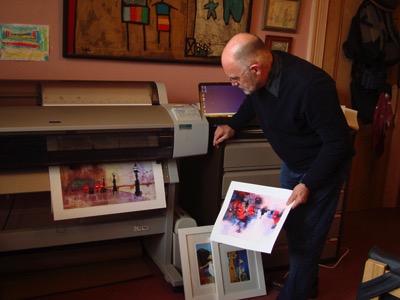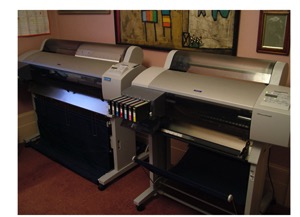Revolution in Printmaking

Crucial differences between old and new printmaking.
Using inkjet technology – inspired by ‘giclee’.
Print-making used to be part of an artists learning process at art school. Woodcuts, etching, engraving, lithography, and silk-screen were typically taught as the stage-by-stage development of the art-form. But things have changed. We have new machine technology, we have computers, and we have the Internet.
So lets look at what this new environment means for an artist.
Commercial four colour machines.
Nowadays there are printing machines that have replaced hand-made lithography created on stone or coated metal plates. These print most of the things we look at and read on paper.
A large commercial lithography machine can produce a product in a fraction of the time it takes to print by hand. But the machine is designed for mass production and use of transient inks on thin paper. Although the cost per print is low, small runs will take just as long to prepare for the large machine as long runs.
So they are not really suitable for creating fine-art in high-quality small editions for the much smaller ‘original print’ market.
Some artists can, and still do, make prints using traditional methods and stone or metal-plate litho’s. An even newer technology is more recent that is very suitable for art publishing. That is the inkjet process.
Giclee. An alternative to commercial lithography.
At first this was named ‘giclee’. No-one knew what that was. It was a useful term that sounded good. Much better than ‘inkjet printing’ which at that time was used for printing one-off proof versions of proposed mass-produced lithography products. The first inkjets used inks that would fade, each one took a long time per print, and the machines had a maximum size because the paper was a one-yard-square sheet at a time.
But nowadays the quality of the inks has radically changed using lightfast pigments. Special paper and canvas substrates are coated and come on rollers. So in the fine-art business we are now happy to just say ‘Inkjet’.

All colours at once.
All previous prints were either monochrome for simplicity or used multiple plates or screens to print multiple colours one at a time. The colours had to be calculated separately and a screen or litho plate created for each colour. A silkscreen using 20 plus colours could take a month to produce at one colour a day accommodating drying and printing time.
The inkjet process prints all the colours at once. A fine art inkjet machine uses seven or more colour cartridges to print a wide rainbow gamut.
But the cost of handmade prints is much more. Or is it?
Print on demand.
An inkjet edition does not have to be printed all at once. It is very practical to print a few examples and explore reaction. This makes a beneficial profit margin impact because the costs of storage space, and over production wastage, are eliminated.
Plus there are these other advantages for the artist printmaker who uses inkjet.
Quality of lightfast inks and substrates.
Printer machine manufacturers like Epson recognized the potential of the fine art and photography market and produced lightfast, pigmented, permanent inks. Other firms supply rolls of coated gloss or matt finish fine-art paper and canvas.
The FATG have tested the lightfastness and paper quality to establish that the longevity of inkjet prints can be the best possible. Certificates of quality are available.
Variety of substrates.
The inkjet process on a fine art machine can print on prepared heavy-weight fine-art paper. Matt or silk or gloss finished paper varieties are available. Rolls of canvas especially coated can be printed and then stretched to make unglazed art-pieces ready for hanging.
Size.
Large format print machines use up to 60” wide rolls of paper or canvas. 44” or 24” width printers are suitable in artist’s studios.
A 44” wide image can be several feet in length making huge prints quite possible.

Even better the size of the print can easily be changed on demand. A variety of sizes of the same image can be offered for art lovers and collectors. The market can be explored and adapted during the life of the print.
Digital master.
Previously the master image was on a physical object such as a screen, plate, or wood-block. The inkjet process uses computer files as the ‘master’. The image can even be created on a computer, or input from a scanned painting, or downloaded from a digital photograph.
Computer image creation can combine photography and fresh digital manipulation to create new styles of art.
File transfer.
The storage, duplication, and online transfer of the digital master file is practical to be shared across many devices and distances. The artist can be a long way away from a commercial printer offering a print service.
Copy and change.
The digital file can be copied and stored, but also changed and developed on a computer to make another new version of the image.
The new version can be captured as new digital file and then further developed to create another image in a series.
Expand, contract, and crop
The printed image can also be cropped to make different dimension prints or different formats. Portrait, square, or landscape, are possible for suitable images. Sections of a scanned original can be made into new print images.
The latest advance is into new unknown territory. The hybrid print, using the print ‘master’, and adding some extra individual originality.
Acrylographs
An inkjet printed onto canvas can be over-painted to add extra details, textures, colours etc. This can create a new image that in turn can be scanned and developed to publish as another inkjet print. These hybrid pictures are a mixture of print and original and can be offered at a price somewhere between the extremes.
It can also mean that the value of ‘first time’ originals goes up as an intermediate priced artwork is offered.
























